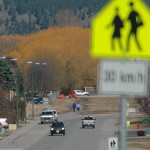Home »

Yellowstone, Custer and a hero’s disgrace
Please excuse what I’m about to do, which on first blush may appear like shameless self-promotion.
On Sept. 21 the Go-Go Grannies invited me to present the travelogue production entitled “Little Big Horn, Yellowstone Park and Custer’s Last Stand.”
Why Custer and Yellowstone Park? Let me explain.
One of the best ways to get to the Little Bighorn National Monument from here is to travel straight through Yellowstone National Park, the first national park created in the U.S., one that sits on a giant underground pool of lava that has exploded into volcanoes many times in the past and continues to shake the ground on a regular basis and that scientists say is sure to explode again on a scale that could plunge the earth into another Ice Age because of the stupendous amount of cloud and ash it would produce.
 And while waiting for that predictable catastrophe, we can see evidence of the disaster coming as iconic Old Faithful (pictured) bursts from the warm ground every 94 minutes or so as well as thousands of other hot springs, puffs of steam rise from the dark basalt soil, and boiling pools of mineralized water from the Grand Prismatic Spring bubble away with every colour of the rainbow like a colossal kettle that never gets turned off.
And while waiting for that predictable catastrophe, we can see evidence of the disaster coming as iconic Old Faithful (pictured) bursts from the warm ground every 94 minutes or so as well as thousands of other hot springs, puffs of steam rise from the dark basalt soil, and boiling pools of mineralized water from the Grand Prismatic Spring bubble away with every colour of the rainbow like a colossal kettle that never gets turned off.
 Yellowstone is a wonder of nature and shows just how beautiful and violent nature can be when fatal circumstances come into play as was the case in 1876 not far from Yellowstone when Lieutenant Colonel George Armstrong Custer made his ignoble charge down Deep Ravine Trail (pictured right) where Sitting Bull, Crazy Horse and Gall were waiting in the largest concentration of native warriors ever to assemble on the northern plains.
Yellowstone is a wonder of nature and shows just how beautiful and violent nature can be when fatal circumstances come into play as was the case in 1876 not far from Yellowstone when Lieutenant Colonel George Armstrong Custer made his ignoble charge down Deep Ravine Trail (pictured right) where Sitting Bull, Crazy Horse and Gall were waiting in the largest concentration of native warriors ever to assemble on the northern plains.
The result was like an exploding volcano with the where’s why’s and what if’s of it still passionately debated to this very day.
For native Americans, who had already been cruelly and viciously uprooted from the land they thrived on for more than 10,000 years, this was a glorious, but brief denouement, to a struggle that would be over in less than a few years. In fact, Crazy Horse was dead within a year of the Little Bighorn victory and Sitting Bull and many of his warriors were living in Canada and slowly starving on handouts from the government until they willingly returned to the U.S. in shame and disgrace.

As for Custer and the 252 members of the 7th Calvary who died with him, they were lionized and mythologized into heroes bigger than life as Americans are so often wont to do. But this storyline changed drastically after the death of Custer’s wife, Elizabeth “Libbie” Custer, a popular Western author, who wrote three books stoking the flames of Custer’s legend. But when Libbie died after a long life of 94 years, historians were quick to revise the Custer legend and a much tarnished and reviled “hero” emerged.
Today Custer is often seen as an arrogant brute who exemplified the worst of the genocidal attacks the American military made on North America’s first peoples, destroying their nomadic culture by imprisoning them on reserves that were little more than concentration camps.
It’s not a pretty story. As a New York Times article said, “Custer went from a handsome martyr to a loathed symbol of manifest destiny.”
But that’s not the whole story either which is plainly stated at the Little Bighorn National Monument by the interpretive staff and all the artifacts you find there and it made me think about “heroism” in a way I’d never thought before.
– Gerry Warner is a retired journalist.








